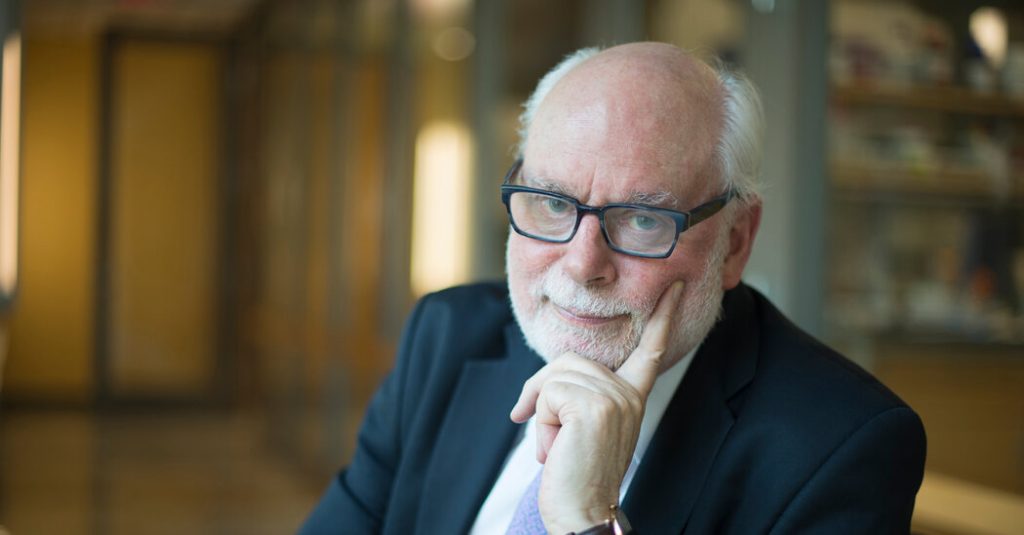J. Fraser Stoddart, a Scottish-born scientist who went from playing with construction sets as a boy to building molecular machines a thousand times smaller than the width of a human hair, known as nanomachines, for which he shared the 2016 Nobel Prize in Chemistry, died on Dec. 30 in Melbourne, Australia. He was 82.
Alison Margaret Stoddart, his daughter, said that he died of cardiac arrest in a hotel while visiting his other daughter, Fiona Jane McCubbin.
Dr. Stoddart and his co-laureates, Jean-Pierre Sauvage of France and Bernard L. Feringa of the Netherlands, first figured out how to build molecules with physical bonds, instead of chemical ones. Those molecules could move freely and became the building blocks for nanomachines. The most basic ones, called catenanes, are interlocking molecules, like links in a chain. They were first synthesized by Dr. Sauvage in 1983.
In 1991, Dr. Stoddart and his team made the next big leap: They created molecules called rotaxanes, which have ring molecules wrapped around other molecules in the shape of a dumbbell. The ring molecule slides back and forth on the dumbbell, whose ends prevent the ring molecule from sliding off. (The word rotaxane comes from Latin roots meaning wheel and axle.)
Dr. Stoddart went on to figure out how to make the ring molecules slide between two set points, like a miniature switch, and then how to put three rotaxanes together to make a platform that could rise and descend 0.7 billionths of a meter — basically a molecular elevator.
Since those early successes, scientists have been able to build molecular machines that contract and extend, replicating the actions of muscles; tiny propellers driven by the energy of light; and, in 2011, a small four-wheel-drive molecular car, albeit one that is only a few billionths of a meter long.
These devices have little practical application so far. But in announcing the prize, the Royal Swedish Academy of Sciences compared their potential to that of an earlier revolution.
“In terms of development,” the academy said, “the molecular motor is at the same stage as the electric motor was in the 1830s, when scientists displayed various spinning cranks and wheels, unaware that they would lead to electric trains, washing machines, fans and food processors.”
Dr. Feringa said that one very likely application would be tiny robots that doctors could inject into patients to seek out and destroy cancer cells or to deliver drugs.
Dr. Stoddart also used his expertise to try to find solutions for other problems.
In 2021, he co-founded H2MOF, a hydrogen storage and transportation company, with Omar Yaghi, another leading chemist. Hydrogen, a clean-burning fuel that could reduce greenhouse gas emissions, is notoriously difficult to transport and store. The company uses technology, based on molecular materials developed by Dr. Stoddart and Dr. Yaghi, that allows hydrogen to be stored and transported in a solid state at room temperature and low pressure. This technology could help make hydrogen a more practical source of clean energy.
And in 2019, Dr. Stoddart introduced a skin-care brand called Noble Panacea, based on porous organic nano vessels that he and some of his students developed. The vessels are said to protect skin-care products from being degraded or contaminated by light, oxygen and water, making them more efficient.
“I guess it’s obvious I am not a typical skin-care brand founder,” Dr. Stoddart told Vogue. “A decade ago my team and I were not thinking specifically of discovering technology with skin-care applications. But inventing things with the goal of having a positive impact on people was always my intention.”
James Fraser Stoddart was born on May 24, 1942, in Edinburgh. He was the only child of Thomas Fraser Stoddart, a tenant farmer, and Jane (Fortune) Stoddart, who had owned a small hotel in Dunbar before her marriage.
The family moved to a farm called Edgelaw, just south of Edinburgh, when James was six months old, and he lived there until he was 25. They raised crops and livestock, but they had no electricity. During the cold winters, the family often huddled together in the kitchen to keep warm. In his Nobel biography, Dr. Stoddart called it “a very simple lifestyle.”
Among his few diversions were Meccano sets, model construction sets popular in Britain at the time, which he could use to build gadgets. He also became a mechanic; he learned to take car and tractor engines apart to clean and repair them and then put them back together.
When he was 8, he transferred from his small village school to Stewart’s Melville College, an elite school for boys in Edinburgh. He attended Edinburgh University, where he concentrated on math and science, including organic chemistry. During his third year, his professor hired him to be part of a research group looking into the structural complexities of acacia plant gums. That set him on his path.
He graduated in 1964 and then completed his Ph.D. in two years.
While at Edinburgh University, he met a brilliant fellow student named Norma Scholan. They married in 1968 and had two daughters. Fiona and Alison followed in their parents’ footsteps, earning top honors and doctorates in chemistry, Fiona from Imperial College in London and Alison from the University of Cambridge.
Norma Stoddart died in 2004. In addition to his daughters, Dr. Stoddart is survived by four grandsons and a granddaughter.
Dr. Stoddart did postdoctoral research at Queen’s University in Kingston, Ontario, then returned to England to work as a researcher at the University of Sheffield. He joined the faculty in 1970.
In 1978, he was hired as a researcher by Imperial Chemical Industries, a British chemical company that specialized in making herbicides. It was there that he began to imagine how it might be possible to build molecules with physical bonds. In his Nobel interview, he said that he got the idea partly from the characteristics of the chemicals that the company used to make its fertilizers.
Until then, researchers had tried to synthesize catenanes by “matching like with like” types of chemicals. The success rate was less than 1 percent. But the herbicide plant was successfully combining ingredients from different families of chemicals, and Dr. Stoddart realized that this could be the key to designing catenanes.
He had the right idea, but it was still difficult, and Dr. Stoddart and his colleagues faced skepticism from other scientists who doubted that nanomachines were even possible. It would be another decade before they succeeded.
After three years at ICI, Dr. Stoddart returned to Sheffield, where he continued his research.
In 1990, he was hired by the University of Birmingham, where he first synthesized a rotaxane. In 1997, he accepted a post at the University of California, Los Angeles, and in 2008 he was hired by Northwestern University, which created a research institute for nanotechnology in his honor, the Stoddart Mechanostereochemistry Group.
In 2023, he was recruited by the University of Hong Kong. He was working there at his death.
In addition to the Nobel Prize, Dr. Stoddart received the Albert Einstein World Award of Science in 2007. He was knighted by Queen Elizabeth II in 2006.
During his career, Dr. Stoddart mentored and oversaw the doctorates and research of more than 400 students from 43 countries. But he treated them more as partners than acolytes.
“I’ve recognized that you put a team together and you allow the brains of 30 people to work on something rather than a top-down approach where you say I have all the ideas and these are just pairs of hands or slaves,” he said in his Nobel interview. He added: “I am rebelling against the hierarchical system that visited me in the early part of my career, and I said I am not going to go down that road. I am going to fashion something that is new and I’m going to make it possible for young people with amazing talent to express their creativity.”




